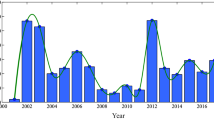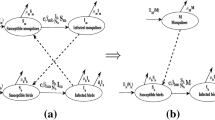Abstract
There are more than 300 avian species that can transmit West Nile virus (WNv). In general, the corvid and non-corvid families of birds have different responses to the virus, with corvids suffering a higher disease-induced mortality rate. By taking both corvids and non-corvids as the primary reservoir hosts and mosquitoes as vectors; we formulate and study a system of ordinary differential equations to model a single season of the transmission dynamics of WNv in the mosquito–bird cycle. We calculate the basic reproduction number and analyze the existence and stability of the equilibria. The existence of a backward bifurcation gives a further sub-threshold condition beyond the basic reproduction number for the spread of the virus. We also discuss the role of corvids and non-corvids in spreading the virus. We conclude that knowledge of the relative abundance of corvid bird species and other mammals assist us in accurate estimation of the epidemic of WNv.















Similar content being viewed by others
References
Blayneh K, Gumel A, Lenhart S, Clayton T (2010) Backward bifurcation and optimal control in transmission dynamics of West Nile virus. Bull Math Biol 72:1006–1028
Bowman C, Gumel AB, Wu J, van den Driessche P, Zhu H (2005) A mathematical model for assessing control strategies against West Nile virus. Bull Math Biol 67(5):1107–1133
Buck P, Liu R, Shuai J, Wu J, Zhu H (2009) Modeling and simulation studies of West Nile Virus in Southern Ontario Canada. In: Ma Z, Wu J, Zhou Y (eds) Modeling and dynamics of infectious diseases. World Scientific Publishing, London
Castillo-Chavez C, Song B (2004) Dynamical models of tuberculosis and their applications. Math Biosci Eng 1(2):361–404
Carr J (1981) Applications of centre manifold theory. Springer, Berlin
Center for Disease Control and Prevention (CDC) (1999) Update: West Nile-like viral encephalitis—New York. Morb. Mortal Wkly. Rep. 48:890–892
Center for Disease Control and Prevention (CDC) (2001) Weekly update: West Nile virus activity—United States. Morb. Mortal Wkly. Rep. 50:1061–1063
Cruz-Pacheco G, Esteva L, Montano-Hirose J, Vargas D (2005) Modelling the dynamics of West Nile virus. Bull Math Biol 67:1157–1172
Gourley A, Liu R, Wu J (2007) Some vector borne diseases with structured host populations: extinction and spatial spread. J Appl Math 67:408–433
Gubler J (1989) The arboviruses: epidemiology and ecology. II. CRC Press, Florida
Guckenheimer J, Holmes P (1983) Nonlinear oscillations, dynamical systems and bifurcations of vector fields. Springer, Berlin
Hamer L, Kitron D, Goldberg L, Brawn D, Loss R, Ruiz O, Hayes B, Walker D (2009) Host selection by Culex pipiens mosquitoes and West Nile virus amplification. Am J Trop Med Hyg 80(2):268–278
Jang S (2007) On a discrete West Nile epidemic model. J Comput Appl Math 26(3):397–414
Jiang J, Qiu Z, Wu J, Zhu H (2009) Threshold conditions for West Nile virus outbreaks. Bull Math Biol 71(3):627–647
Kenkre M, Parmenter R, Peixoto D, Sadasiv L (2005) A theoretic framework for the analysis of the West Nile virus epidemic. Math Comput Model 42:313–324
Komar N, Langevin S, Hinten S, Nemeth N, Edwards E (2003) Experimental infection of North American birds with the New York 1999 strain of West Nile Virus. Emerg Infect Dis 9(3):311–322
Kurt D, Reed MD, Jennifer K, James S, Henkel S, Sanjay K (2003) Birds, migration and emerging zoonoses: West Nile virus, Lyme disease, influenza A and enteropathogens. Clin Med Res 1(1):5–12
Lewis M, Renclawowicz J, van den Driessche P (2006a) Traveling waves and spread rates for a West Nile virus model. Bull Math Biol 68(1):3–23
Lewis M, Renclawowicz J, van den Driesssche P, Wonham M (2006b) A comparison of continuous and discrete-time West Nile virus models. Bull Math Biol 68(3):491–509
Patrick Z (2005) West Nile virus national report on dead bird surveillance. Canadian Cooperative Wildlife Health Centre, Saskatoon
Peterson R, Marfin A (2002) West Nile virus: a primer for the clinician. Ann Intern Med 137(3):173–179
Public Health Agency of Canada, West Nile virus MONITOR: maps & Stats, http://www.phac-aspc.gc.ca/wnv-vwn/. Accessed 5 Oct 2012
Russell R, Dwyer D (2000) Arboviruses associated with human disease in Australia. Microbes Infect 2(1):693–704
Smithburn C, Hughes P, Burke W, Paul H (1940) A neurotropic virus isolated from the blood of a native of Uganda. Am J Trop Med Hyg 20:471–492
Swayne D, Beck R, Zaki S (2000) Pathogenicity of West Nile virus for Turkeys. Avian Dis 44:932–937
Thomas M, Urena B (2001) A mathematical model describing the evolution of West Nile-like encephalitis in New York City. Math Comput Model 34(7):771–781
van den Driessche P, Watmough J (2002) Reproduction numbers and sub-threshold endemic equilibria for compartmental models of disease transmission. Math Biosci 180:29–48
Wan H, Zhu H (2010) The backward bifurcation in compartmental models for West Nile virus. Math Biosci 227(1):20–28
Wonham M, de-Camino-Beck T, Lewis M (2004) An epidemiological model for West Nile virus: invasion analysis and control applications. Proc R Soc 271:501–507
Author information
Authors and Affiliations
Corresponding author
Additional information
H. Zhu’s work was supported by ERA, an Early Researcher Award of Ontario, the Pilot Infectious Disease Impact and Response Systems Program of Public Health Agency of Canada and Natural Sciences and Engineering Research Council of Canada.
Lenhart’s work was partially supported by the National Institute for Mathematical and Biological Synthesis through the National Science Foundation award # EF-0832858.
Appendix
Appendix
In this Appendix, the proof of Theorem 4.1 is given. It employs Theorem 6.1 (demonstrated below), which is adopted from Castillo-Chavez and Song (2004) that is, in turn, based on the use of the center manifold theory (Carr 1981; Guckenheimer and Holmes 1983).
Theorem 6.1
(Castillo-Chavez and Song 2004) Consider the following general system of ordinary differential equations with a parameter
Without loss of generality, it is assumed that \(0\) is an equilibrium for system (6.1) for all values of the parameter \(\phi ,\) (that is \(f(0,\phi ) = 0 \ \ \ \forall \phi \)). Assume
-
1.
\(B= D_{x}f(0,0) = \left( \frac{\partial f_{j}}{\partial x_{i}},0,0\right) \) is the linearized matrix of system (6.1) around the equilibrium \(0\) with \(\phi \) evaluated at \(0\). Zero is a simple eigenvalue of \(B\) and all other eigenvalues of \(B\) have negative real parts;
-
2.
Matrix \(B\) has a right eigenvector \(w\) and a left eigenvector \(v\) corresponding to the zero eigenvalue. Let \(f_{k}\) be the \(k{th}\) component of \(f\) and
$$\begin{aligned} a&= \sum ^{8}_{k,i,j} v_{k}w_{i}w_{j} \frac{\partial ^{2}f_{k}}{\partial x_{i} \partial x_{j}} (0,0)\\ b&= \sum ^{8}_{k,i} v_{k}w_{i} \frac{\partial ^{2}f_{k}}{\partial x_{i} \partial \phi } (0,0). \end{aligned}$$The local dynamics of system (6.1) around \(0\) are totally determined by \(a\) and \(b\).
-
(a)
In the case where \(a > 0; b > 0,\) we have that when \( \phi < 0\) with \(\left| \phi \right| \) close to zero, \(0\) is locally asymptotically stable and there exists a positive unstable equilibrium; when \(0<\phi << 1, \) \(0\) is unstable and there exists a negative and locally asymptotically stable equilibrium.
-
(b)
In the case where \(a < 0; b < 0,\) we have that when \( \phi < 0\) with \(\left| \phi \right| \) close to zero, \(0\) is unstable; when \(0<\phi << 1,\) 0 is locally asymptotically stable, and there exists a positive unstable equilibrium;
-
(c)
In the case where \(a > 0; b < 0,\) we have that when \( \phi < 0\) with \(\left| \phi \right| \) close to zero, 0 is unstable and there exists a locally asymptotically stable negative equilibrium; when \(0<\phi << 1,\) \(0\) is stable and a positive unstable equilibrium appears
-
(d)
In the case where \(a < 0; b > 0,\) we have that when \(\phi \) changes from negative to positive, \(0\) changes its stability from stable to unstable. Correspondingly, a negative unstable equilibrium becomes positive and locally asymptotically stable.
-
(a)
To apply Theorem (6.1), the following simplification and change of variables are made on the system (2.1). First of all, let \(x_{1}=M_{s}, x_{2}=M_{i}, x_{3}=B_{1s}, x_{4}=B_{1i}, x_{5}=B_{1r}, x_{6}=B_{2s}, x_{7}=B_{2i}, x_{8}=B_{2r}.\) Further, by using the vector notation \(X=(x_{1},x_{2},x_{3},x_{4},x_{5},x_{6},x_{7},x_{8})^{T},\) the system (2.1) can be written in the form of \(\frac{dX}{dt} = F(x),\) with \(F=(f_{1},f_{2},f_{3},f_{4},f_{5},f_{6},f_{7},f_{8})^{T},\) such that
Assume that \((1-q)d_{m}\mu _{2}-\beta _{m}b_{m}d_{b} > 0.\) Choose \((\delta _{1},\delta _{2})\) as a bifurcation parameters. As a result of solving \(R_{0}=1,\) backward bifurcation occurs at any point on the curve defined at Eq. (4.1) (see Sect. 4).
The Jacobian matrix of the system (2.1) at \(E_{1}\) (with \((\delta _{1},\delta _{2})\) satisfying Eq. (4.1)) is given by
The eigenvalues of the Jacobian matrix can be obtained by the following equation:
where \(a_{2} = \delta _{1}+\delta _{2}+(1-q)d_{m}\) and \(a_{1}=\delta _{2}(\delta _{1}+(1-q)d_{m}).\)
Thus, the Jacobian matrix has a simple zero eigenvalue and all the other eigenvalues have negative real parts for all \(r_{m}>d_{m}\). Hence, Theorem (6.1) can be used to analyze the dynamics of the system (2.1).
When \(R_{0}=1\), it can be shown that the Jacobian matrix has a right eigenvector (associated to the zero eigenvalue), given by \(w=(w_{1},w_{2},w_{3},w_{4},w_{5},w_{6},w_{7},w_{8})^{T},\) where \(w_{1}=-w_{2},\, w_{2}=w_{2},\,w_{3}=-\beta _{b}b_{m}\frac{\tilde{B_{1}}}{d_{b} \tilde{B}} w_{2},\,w_{4}=\beta _{b}b_{m}\frac{\tilde{B_{1}}}{\delta _{1} \tilde{B}} w_{2},\,w_{5}=\beta _{b}b_{m}\frac{\nu _{1} \tilde{B_{1}}}{\delta _{1} d_{b} \tilde{B}} w_{2},\,w_{6}=-\beta _{b}b_{m}\frac{\tilde{B_{2}}}{d_{b} \tilde{B}} w_{2},\,w_{7}=\beta _{b}b_{m}\frac{\tilde{B_{2}}}{\delta _{2} \tilde{B}} w_{2},\,w_{8}=\beta _{b}b_{m}\frac{\nu _{2} \tilde{B_{2}}}{\delta _{2} d_{b} \tilde{B}} w_{2}.\)
Similarly, the components of the left eigenvector of Jacobian matrix (corresponding to the zero eigenvalue), denoted by \(v=(v_{1},v_{2},v_{3},v_{4},v_{5},v_{6},v_{7},v_{8})^{T},\) are given by \(v_{1}=0, v_{2}=v_{2},v_{3}=0,v_{4}=\beta _{m}b_{m}\frac{\tilde{M}}{\tilde{B}}v_{2}, v_{5}=0, v_{6}=0, v_{7}=\beta _{m}b_{m}\frac{\tilde{M}}{\tilde{B}}v_{2}, v_{8}=0.\)
Let \(a\) and \(b\) be the coefficients defined in Theorem (6.1). We can calculate \(a\) as follows: for the transformed system (6.2), the associated non-zero partial derivatives of \(f\) (evaluated at the DFE \(E_{1}\)) are given by
Then,
Then, from the above equation we can conclude that \(a\) is negative if and only if \(A\) satisfies the Eq. (4.4).
From Eq. (4.1) we can see that \(\delta _{1} \ge \frac{\alpha \tilde{B_{1}}\delta _{2}}{\delta _{2} -\alpha \tilde{B_{2}}},\) if and only if \(R_{0}\le 1.\) Using the same notation as in Castillo-Chavez and Song (2004), \(\phi =\frac{\alpha \tilde{B_{1}}\delta _{2}}{\delta _{2}-\alpha \tilde{B_{2}}} - \delta _{1},\) then \(\phi \ge 0\) if and only if \(R_{0}\ge 1,\) and \(\phi < 0\) if and only if \(R_{0}<1.\)
We can calculate \(b\) by substituting the vectors \(v\) and \(w\) and the respective partial derivatives (evaluated at the DFE \(E_{1}\)) into the expression
which implies
Since coefficient \(b\) is always positive, it follows that the system (2.1) will undergo backward bifurcation if the coefficient \(a\) is negative.
Rights and permissions
About this article
Cite this article
Abdelrazec, A., Lenhart, S. & Zhu, H. Transmission dynamics of West Nile virus in mosquitoes and corvids and non-corvids. J. Math. Biol. 68, 1553–1582 (2014). https://doi.org/10.1007/s00285-013-0677-3
Received:
Revised:
Published:
Issue Date:
DOI: https://doi.org/10.1007/s00285-013-0677-3
Keywords
- West Nile virus
- Mosquito
- Corvid and non-corvid birds
- Modeling
- Transmission dynamics
- Equilibrium and stability
- Backward bifurcation
- Spread and control




